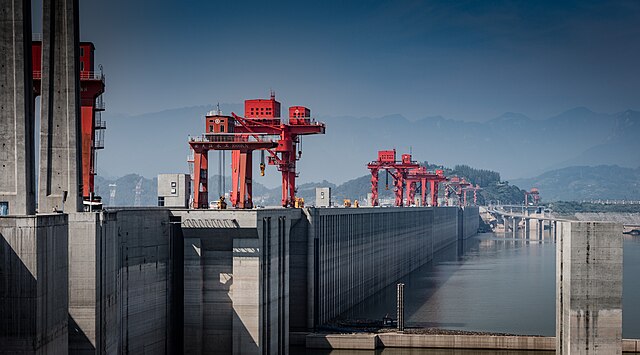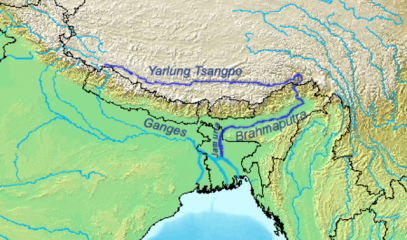Beijing begins construction the Motuo Dam in Tibet, the world's largest
At over 4,000 metres above sea level on the Yarlung Tsangpo, Tibet’s sacred river that becomes the Brahmaputra in India, the dam includes a system of five cascading plants that will produce enough energy to power the entire United Kingdom. Concerns have been raised about its location in an earthquake-prone area and the forced displacement of populations. The political implications will impact relations with Delhi and Dhaka on the crucial issue of water management.
Milan (AsiaNews/Agencies) – Construction has officially begun on the world's most ambitious hydroelectric project, scheduled to enter into operation in 2030. The Motuo Dam will rise on the lower reaches of the Yarlung Tsangpo River, the highest in the world.
Considered sacred, the river rises on the Tibetan plateau at an altitude of approximately 4,500 metres, flows into India, where it takes the name Brahmaputra, and finally reaches Bangladesh, becoming the Jamuna.
The project involves the construction of five cascading hydroelectric plants, capable of generating up to 300 billion kilowatt-hours per year, the equivalent of the United Kingdom's annual electricity consumption in 2024.
To maximise the river's energy output, the watercourse will be partially diverted – in a stretch of just 50 kilometres, it will drop over 2,000 metres, unleashing more hydroelectric power than the Three Gorges Dam, China’s other mega-plant, which operates on the Yangtze River in Hubei province.
The project represents a crucial step in Beijing’s strategy to achieve zero emissions by 2060. However, like all projects of this scale, the dam will not only have an energy impact, but also economic, environmental, and political repercussions.
According to Chinese state news agency Xinhua, the new structure will have a price tag of 1.2 trillion yuan (US$ 167 billion) – more than double the cost of the Three Gorges Dam (US$ 64 billion) promising a significant boost to the domestic economy.
The sectors most affected are construction, cement, and steel. Shares of Power Construction Corp., China Energy Engineering Corp., Huaxin Cement Co., and Anhui Conch Cement Co. rose significantly following the news.
According to Citigroup Inc., the project could boost China's GDP growth by nearly 0.1 per cent in the first year of construction. However, due to its location and the effects of climate change, some experts believe the project is exposed to enormous risks.
First, there is a high seismic risk. The Yarlung Tsangpo Gorge is in one of Asia's most active tectonic zones, where the Indian plate is pushing under the Eurasian plate, uplifting the Himalayas.
Furthermore, since the basin's glaciers are shrinking due to climate change, the frequency of landslides along the river's course is up. In this very area, the collapse of a glacier in 2021 triggered a massive landslide with an estimated volume of 100 million tonnes of rock and ice.
In addition to environmental damage, such events cause serious displacement crises for entire communities.
In an interview reported by Columbia Climate School, Bryan Tilt, an anthropology professor at Oregon State University who studies dams and development in China, stressed that resettlement caused by major infrastructure projects represents "a contentious social and political issue in China today," noting that, given that the region is an ethnically Tibetan area, the management of the situation could prove even more controversial.
The smaller Three Gorges Dam displaced approximately 1.4 million people.
Finally, because the Yarlung Tsangpo River flows through the state of Arunachal Pradesh in northeastern India, which China claims as its territory, and then flows into the Brahmaputra River on its way to Bangladesh, the project is particularly sensitive diplomatically.
In January, India formally expressed its concerns, and in the following months, the External Affairs Ministry announced preventative and corrective measures to protect the country’s national interests.
The recent spike in tensions between India and Pakistan underscores even more the risks associated with water control.
According to local media, the dam could divert up to 80 per cent of the river's flow or, conversely, increase flood risks in the downstream areas in Arunachal and the neighbouring state of Assam.
Additionally, a study by the Lowy Institute, an Australia-based think tank, noted how China's control over the Tibetan Plateau's water resources gives Beijing an edge over India’s economy.
New Delhi responded by relaunching one of its own projects, namely the construction of the Upper Siang Multipurpose Project, a dam on the Siang River (the name by which the Brahmaputra is known in Arunachal Pradesh).
The project’s primary objective is flood management and the protection of local populations, while energy production would be a secondary benefit.
Surprisingly, Assam Chief Minister Himanta Biswa Sarma is less critical. In his view, reducing the flow of water could help cushion the impact of flooding, a frequent problem in the area.
"I am not immediately worried because [the] Brahmaputra is a mighty river and it is not dependent on a single source (of water),” he explained.
Bangladesh has also expressed its concerns to China about the effects of the hydroelectric project on the Yarlung Tsangpo.
At a bilateral meeting, the two countries emphasised the need for greater cooperation, coming on the heels of the 50th anniversary of the establishment of diplomatic relations between Dhaka and Beijing, celebrated this year.
Still, according to Sharif Jamil, a Bangladeshi environmentalist and national representative for the NGO Riverkeeper, the country risks being caught between unilateral decisions by China and India, without any real power in managing water resources.
Complicating the situation, Jamil adds, no binding treaty exists among the countries of the Ganges-Brahmaputra-Meghna (GBM) river basin regulating the sharing of transboundary waters.
In other areas too, China exploits water flows to its advantage at the expense of downstream states and the environment.
In the Mekong Basin, already affected by climate change, Chinese hydropower development is threatening the region's food and water security because Beijing has built several dams upstream that allow it to control the river's flow.
It is estimated that China has built 22,000 large dams to help fuel decades of rapid industrialisation and economic growth – about 40 per cent of the world’s total.
22/08/2020 12:09








.png)










